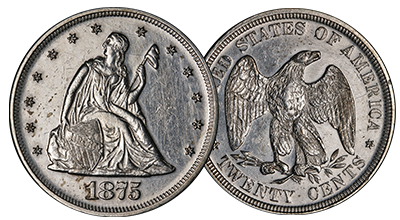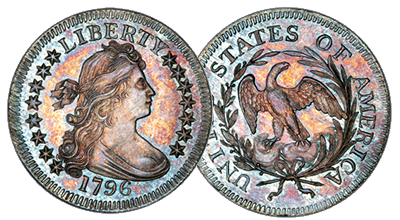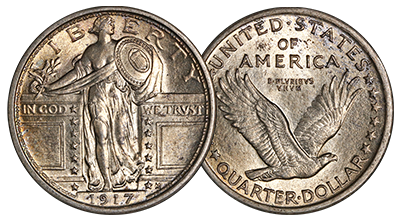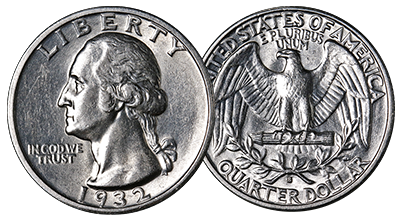Buy Rare Quarters Online
The United States Quarter is a coin that has a face value of 25 cents and that has been struck since 1796. Quarters originally consisted of 90% silver and 10% copper. However, in 1965, the coin's composition changed and the current US quarter contains 91.67% copper and 8.33% nickel. Continue reading to learn more about rare quarters.
Quarters are one of the most commonly collected coins in the United States. Bullion Shark is proud to offer the finest Twenty Cents, Draped Bust Quarters, Capped Bust Quarters, Seated Liberty Quarters, Barber Quarters, Standing Liberty Quarters, and Washinton Quarters on the market.
Twenty Cent
The American Twenty Cent piece was struck between 1875 and 1878. However, from 1876 until 1878, these coins were only produced and circulated for collectors and were not issued for general circulation.
The Twenty Cent features an image of Liberty holding a flag surrounded by 13 stars to signify the 13 founding states on the observe side. The design was created by Christian Gobrecht, but was re-engraved by William Barber, who also designed the left-facing bald eagle, which is featured on the reverse side of the coin.
The mintages of the Twenty Cent piece range from 10,000 to 1,155,000.
Draped Bust Quarter
The Draped Bust Quarter was the original Quarter design produced in 1796. The obverse of the coin shows Liberty facing to the right with flowing hair behind her. The reverse side depicts a wreath tied with a bow surrounding a small eagle sat on a cloud. Both sides of the Draped Bust Quarter were designed by Gilbert Stuart.
The Draped Bust Quarter continued to be produced until 1807. The lowest mintage of the coin occurred in 1796 when only 6,146 coins were struck, and the highest mintage was reached in 1807 when 220,643 pieces were made.
Capped Bust Quarter
The production of the quarter was briefly halted between 1807 and 1814. However, the quarter returned to production in 1815 with the Capped Bust Quarter. This coin was struck until 1838, although the coin's size was reduced in 1828.
Despite the change in size, the coin's design remained the same throughout its 23-year run. The Capped Bust Quarter was designed by John Reich, and the obverse side featured Liberty wearing a cloth cap with the word "Liberty" inscribed upon it. The reverse of the coin features an eagle perched on a branch while holding three arrows.
The mintages of the Capped Bust Quarter ranged from 4,000 to 1,952,000.
Seated Liberty Quarter
The Seated Liberty Quarter began production in 1838 and was regularly struck until 1891.
The Seated Liberty Quarter was designed by Christian Gobrecht, who also designed the obverse side of the Twenty Cent piece. The obverse side of the Seated Liberty shows Liberty holding both a flag and a shield with 13 stars surrounding her. The reverse side featured an eagle, shield, and three arrows until 1866 when a motto was added above the eagle. The motto read "In God We Trust."
The Seated Liberty Quarter mintages range from 8,000 to 17,816,000.
Barber Quarter
The Barber Quarter replaced the Seated Liberty Quarter in 1892 and was struck until 1916. The designer of the Barber Quarter was the engraver Charles E Barber. His design featured an image of Liberty wearing a leaf crown, 13 stars, and the inscription "In God We Trust" on the obverse side of the coin. An eagle clutching thirteen arrows appears on the reverse side.
The lowest mintage of the Barber Quarter is 40,000, and the highest is 12,624,00.
Standing Liberty Quarter
The Standing Liberty Quarter was produced between 1916 and 1930. There were a variety of designs featured on the Standing Liberty Quarter, all of which were designed by Hermon MacNeil. The original design included Liberty holding an olive branch and a broadsword with one bare breast on the obverse side. This design was later changed to include a chain vest that covered Liberty's breast.
Each incarnation of the reverse side of the Standing Liberty Quarter includes an eagle with 13 stars, but the placement of the stars was changed in 1917.
The mintage of this coin ranges from 52,000 to 27,860,000.
Washington Quarter
The Washington Quarter is the current quarter of the United States and was the final silver quarter to be struck as the Mint transitioned to copper-nickel coinage in 1965. The Washington Quarter entered circulation in 1932 and was designed by the sculptor John Flanagan.
The Obverse side of the Washington Quarter features a bust of George Washington, while the reverse side features an eagle with outstretched wings and a bundle of arrows.
The mintage of the Washington Quarter ranges from 408,000 to 1,819,717,540.
Rare Quarters For Sale
How do the values of these rare quarters compare to each other?
The values of rare quarters vary significantly based on several factors, including age, rarity, condition, and historical significance. For instance, the Draped Bust Quarter, being one of the earliest quarter designs and having a very low mintage in its first year (1796), is highly prized among collectors and can fetch substantial sums, especially for coins in finer conditions. On the other hand, the Standing Liberty Quarters, particularly those from the earliest years with the original design, also hold considerable value due to their artistic appeal and the historical context of their modifications. However, because the Standing Liberty Quarters were minted more recently and in larger quantities than the Draped Bust Quarters, they may not reach the astronomical values of their older counterparts, except in cases of exceptionally rare variations or conditions. The value comparison among these quarters is nuanced, with specific rarities like the 1916 Standing Liberty Quarter or the 1796 Draped Bust Quarter often commanding higher prices at auction due to their rarity and demand among collectors.
What specific factors contribute to the rarity and value of these quarters?
Several specific factors contribute to the rarity and value of rare quarters, beyond just low mintage numbers. For one, the condition of the coin is paramount; quarters that have survived in high-grade conditions (e.g., MS-65 and above) are far more valuable than those in lower grades. Historical significance also plays a crucial role; quarters that were minted during significant periods in U.S. history or that represent a change in design or composition can be more sought after. Errors and variations within a particular issue can greatly increase a quarter's rarity and value. For example, a 1932 Washington Quarter with a clear, double-die error would be far more valuable than its standard counterparts. Additionally, provenance, or the history of a particular coin's ownership, can add to its allure and value, especially if it was previously owned by a notable collector or featured in a famous collection.
Are there any notable auction records or sales for these rare quarters?
Yes, there have been several notable auction records and private sales for rare quarters that underscore their value and collectibility. For instance, high-grade examples of the 1796 Draped Bust Quarter have sold for over $100,000 at auction, reflecting its rarity and demand among collectors. Similarly, the 1916 Standing Liberty Quarter, particularly those in uncirculated condition, has seen auction prices exceeding $50,000 due to its low mintage and historical significance as the first year of the Standing Liberty design. The 1932-D Washington Quarter, known for its low mintage and status as a key date in the Washington Quarter series, has also fetched significant sums, with high-grade examples selling for tens of thousands of dollars. These sales highlight the significant investment potential of rare quarters and their appeal to both collectors and investors.
Learn more about: quarters worth money, state quarters worth money, what makes a 1964 kennedy half dollar rare, pennies worth money list, 1945 penny value, 1935 wheat penny value, silver quarter years, how many dimes in a roll, 1941 wheat penny value, 1965 quarter value.
Rare Quarters FAQ
The rarest quarters include the 1796 Draped Bust Quarter, the 1804 Draped Bust Quarter, the 1823/2 Capped Bust Quarter, the 1838-O Seated Liberty Quarter, and the 1901-S Barber Quarter. These coins are highly sought after due to their low mintage numbers, historical significance, and scarcity.
Identifying a rare quarter involves checking the date, mint mark, design features, and condition. Key dates and mint marks often indicate rarity. Additionally, consulting a reputable coin guide or a professional numismatist can help in identification.
Factors contributing to a quarter's rarity include low mintage numbers, historical significance, condition (especially high-grade examples), and unique errors or variations in design. Coins that were minted in limited quantities or have survived in exceptional condition over time are particularly rare.
The value of a rare quarter depends on its rarity, condition, demand among collectors, and specific characteristics like mint marks and errors. Values can range from a few hundred dollars to several thousand dollars for particularly rare or high-grade examples.
Rare quarters can be found through rare coin dealers, auctions, estate sales, and sometimes in circulation. Joining coin collecting clubs and attending numismatic shows can also provide opportunities to find rare quarters.
Yes, some modern quarters are considered rare, such as certain State Quarters with minting errors or low mintage numbers, like the 1999-P Delaware Spitting Horse error or the 2008-D Oklahoma Quarter with a double die obverse. The 2020-W quarters with the "V75" privy mark are also sought after.
The 1913 Liberty Head Nickel (often mistakenly included in quarter discussions due to its similar size) is one of the most valuable U.S. coins. Among true quarters, the 1901-S Barber Quarter is extremely valuable, with high-grade examples fetching over $100,000 at auctions.
While it's unlikely, it is possible to find quarters with errors or those from the early years of the State Quarters program that have increased in value. Regularly checking change and being knowledgeable about what to look for can sometimes yield valuable finds.
Selling a rare quarter involves getting it appraised by a reputable dealer or numismatist, then selling it through a coin dealer, at an auction, or via online platforms. Ensuring the coin is graded by a professional grading service can also help achieve a better selling price.
If you believe you have a rare quarter, the first step is to have it authenticated and graded by a professional grading service like PCGS or NGC. Then, consult with reputable coin dealers or numismatists to understand its market value and potential selling options.








